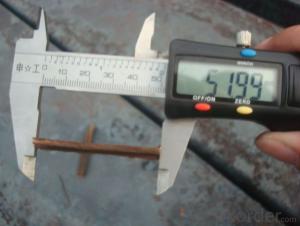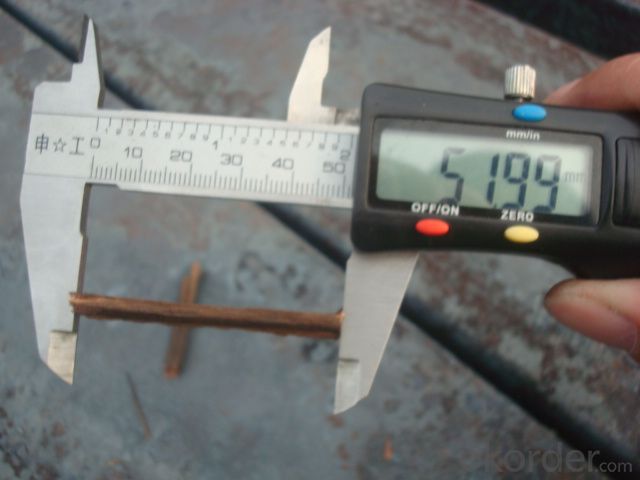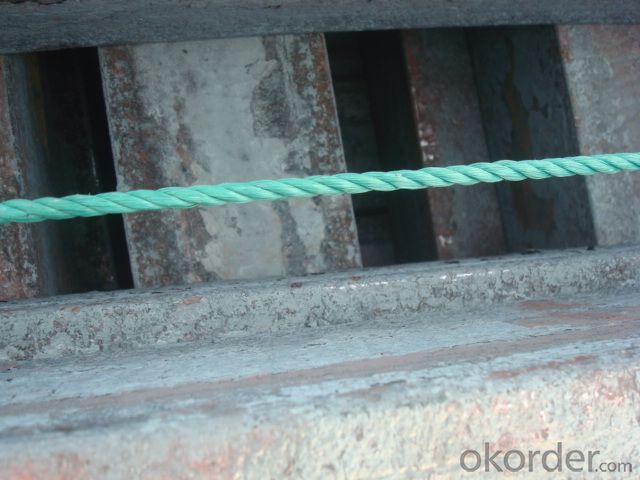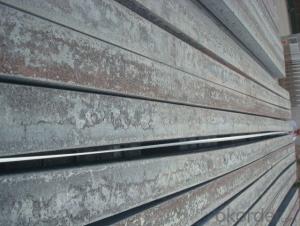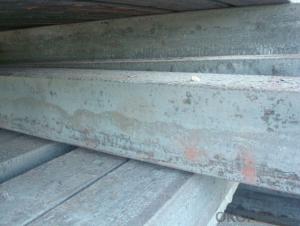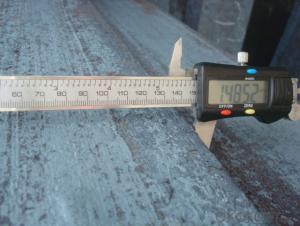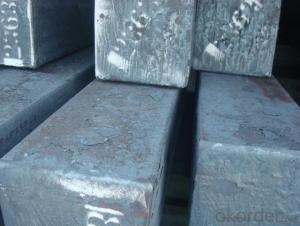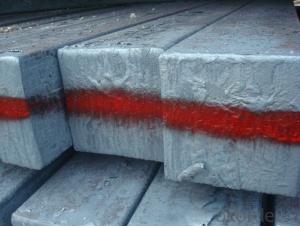Alloyed Continue Casting Steel Billet by Blast Furnace with Good Quality
- Loading Port:
- Tianjin
- Payment Terms:
- TT OR LC
- Min Order Qty:
- 1000 m.t.
- Supply Capability:
- 10000 m.t./month
OKorder Service Pledge
OKorder Financial Service
You Might Also Like
Alloyed Continue Casting Steel Billet by Blast Furnace with Good Quality
1.Structure of Alloyed Continue Casting Steel Billet by Blast Furnace with Good Quality
Alloyed Continue Casting Steel Billet by Blast Furnace with Good Quality is the raw material of all kinds of steel mill. Billet section of square, round, flat, rectangular and abnormity, etc Several, mainly related to shape of rolled products. Simple rolled section steel, choose cross section of square billet or rectangular billet. rolling The sector products such as flat steel, Angle steel, select the rectangular billet or slab. Had better profiled billet when production beams, channels, and in rolling process Lines and improve the yield. The raw material of round billet is the production of seamless tube.
2.Main Features of Alloyed Continue Casting Steel Billet by Blast Furnace with Good Quality.
Alloyed Continue Casting Steel Billet by Blast Furnace with Good Qualitysection size should meet the requirements of rolling deformation and finished product quality, but also roll strength and biting condition of restrictions. General steel Billet section height H. And the roll diameter D The ratio of the ( namely H/D) Should be less than or equal to zero 0.5 . Length of steel billet by finishing temperature, Rolling time and the length of the product Or times ruler. When heated too long accident prone to bump the furnace wall of steel, too short, furnace bottom utilization rate is not high, influence the heating furnace production. For the production Choose a variety of steel and steel billet, should consider the affinities of billet, as far as possible in order to improve the productivity of the roughing mill, simplify the stock management of workshop.
3. Alloyed Continue Casting Steel Billet by Blast Furnace with Good Quality Images
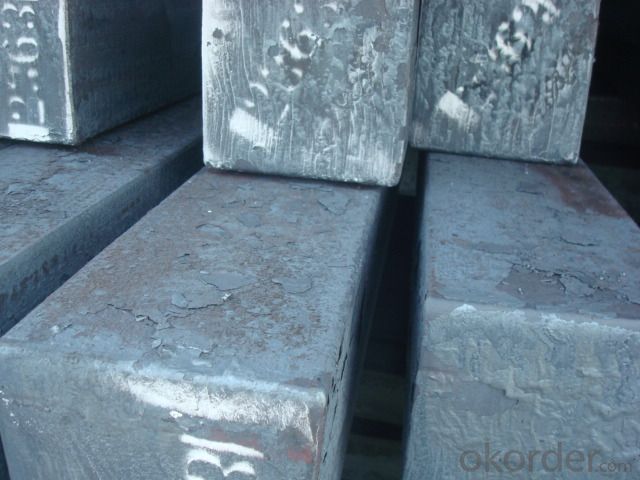
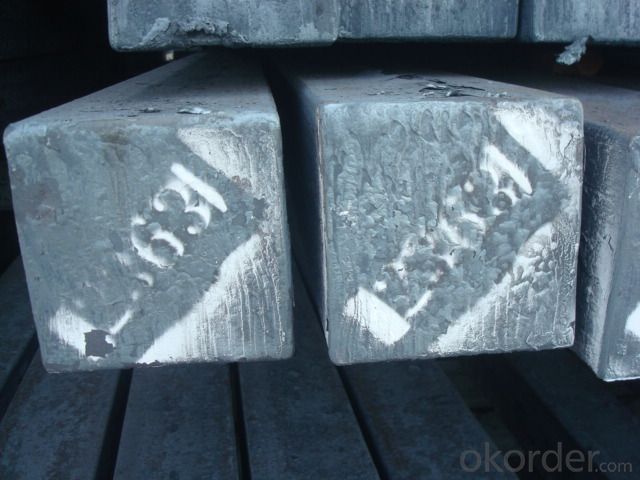
4. Alloyed Continue Casting Steel Billet by Blast Furnace with Good Quality Specification
Alloyed Continue Casting Steel Billet by Blast Furnace with Good Qualityrolled steel, after processing can be used for mechanical parts, forging parts, processing all kinds of steel, steel Q345B channel steel, wire rod is the role of the billet. Steel billet is used in the production of semi-finished products, generally cannot be used directly for the society. Steel billets and steel are strictly divided into standard, cannot decide to whether the business enterprise of the final product, and according to unified standards to perform the whole society. Typically, billet and the steel is relatively easy to distinguish, but for some steel billet, and have the same specification and same steel purposes (such as rolling tube billet), whether can be used for other industries, whether through steel processing process, whether through a finished product rolling mill processing to distinguish
Material standard The editor Range of thickness: 150-240 - mm + / - 5 mm width range: 880-1530 - mm + / - 20 mm Length: 3700-10000 - mm + / - 500 - mm Cross-sectional size: 64 * 64; 82 * 82; 98 * 98; 124 * 124; 120 * 150; 152 * 164; 152 * 170 mm Length: 9000 mm Section of tolerance: billet: 1.0 + / - 2.0-1.0 + / - 1.0 mm slab: width: + / - 2.0 mm thickness: + / - 3.0 mm The length tolerance: + / - 200 mm Section diagonal tolerance: 3.5-8.0 MM Billet section size protrusions requirements: < 1242 mm, do not allow; > = 1242 mm, < = 2 mm 1242 mm, < = 3 mm Beheading (shear) extension deformation: < 1242 mm billet: no control; The slab: < = 15 mm Surface tilt: no more than billet section 0.1 Bending: every 1 m length is not more than 10 mm The distortion: length < = 5 m, < = 11. ; The length of the < = 7.5 M, < = 5. Material % 3 sp/PS chemical composition: C Mn Si S P
5.FAQ of Alloyed Continue Casting Steel Billet by Blast Furnace with Good Quality
We have organized several common questions for our clients,may help you sincerely:
①How about your company?
A world class manufacturer & supplier of castings forging in carbon steel and alloy steel,is one of the large-scale professional investment casting production bases in China,consisting of both casting foundry forging and machining factory. Annually more than 8000 tons Precision casting and forging parts are exported to markets in Europe,America and Japan. OEM casting and forging service available according to customer’s requirements.
②How can we know the quality of each steel mill you recommand?
We will show you the steel mills website, production line, stock warehouses and other information open for you.And you can hire the SGS inspect for you too.
③How long is the delivery term if we order about 10,000tons?
Our production term is about 30 days. And if your specification is normal, it can be shorter.
- Q: What are the different types of coating processes used for protecting steel billets?
- Steel billets can be protected using various coating processes. These processes serve the purpose of preventing corrosion and enhancing the durability of the steel billets. Some commonly employed coating methods are as follows: 1. Hot-dip galvanizing: In this technique, the steel billets are immersed in molten zinc, creating a safeguarding layer on the surface. This zinc layer ensures long-lasting protection against corrosion. 2. Electroplating: By using an electric current, a thin layer of metals like zinc, nickel, or chrome is deposited onto the steel billets. This metal coating acts as a barrier against corrosion while improving the appearance of the steel. 3. Powder coating: A dry powder is applied to the steel billets and then heated, resulting in the formation of a protective layer. This process offers exceptional resistance against corrosion, chemicals, and UV rays. 4. Thermal spray coating: This method involves spraying melted or heated materials onto the steel billets. The coating materials can include metal alloys, ceramics, or polymers. Thermal spray coatings provide excellent wear resistance, corrosion protection, and thermal insulation. 5. Paint coating: Applying paint onto the steel billets is a popular protective measure. The paint acts as a barrier, preventing moisture and atmospheric elements from causing corrosion while maintaining the steel's appearance. Each coating process has its own advantages and is suitable for different applications. The choice of coating method depends on factors such as the desired level of protection, environmental conditions, and cost considerations.
- Q: What are the main factors affecting the quality of steel billets?
- There are several main factors that can significantly affect the quality of steel billets. These factors include the composition of the steel, the temperature and time of the heating process, the cooling rate, and the presence of impurities. Firstly, the composition of the steel plays a crucial role in determining its quality. The presence of certain elements such as carbon, manganese, and silicon can affect the mechanical properties of the steel, including its strength and hardness. The proper control and balance of these alloying elements are essential to ensure the desired quality of the steel billets. Secondly, the temperature and time of the heating process during the production of steel billets are critical factors. The heating process must be carefully controlled to achieve the optimal temperature for the desired transformation of the microstructure. Overheating or underheating can lead to the formation of undesirable phases or an inconsistent microstructure, which can negatively impact the quality of the billets. The cooling rate is another important factor affecting the quality of steel billets. The cooling process needs to be controlled to achieve the desired microstructure and mechanical properties. Too rapid cooling can result in the formation of brittle phases or residual stresses, while slow cooling can lead to coarse-grained structures with reduced strength. Furthermore, the presence of impurities in the steel can significantly affect its quality. Impurities such as sulfur, phosphorus, and non-metallic inclusions can decrease the mechanical properties and promote the formation of defects in the steel billets. Therefore, strict control of the raw materials and the implementation of effective refining techniques are necessary to minimize the presence of impurities. In conclusion, the main factors affecting the quality of steel billets are the composition of the steel, the temperature and time of the heating process, the cooling rate, and the presence of impurities. By carefully controlling and optimizing these factors, steel manufacturers can produce high-quality billets that meet the desired specifications and performance requirements.
- Q: How do steel billets contribute to the manufacturing of renewable energy equipment?
- Steel billets are an essential component in the manufacturing of renewable energy equipment, such as wind turbines and solar panels. These billets are used to create sturdy and durable structures, including tower bases for wind turbines and frames for solar panels. Additionally, steel billets are crucial in the production of transmission and distribution infrastructure required for renewable energy systems. Their strength and versatility make them an indispensable material in the renewable energy industry, enabling the efficient and reliable generation of green energy.
- Q: Can steel billets be used in the production of aerospace components?
- Indeed, the utilization of steel billets is feasible for the manufacturing of aerospace components. These semi-finished steel products can undergo further processing to attain an assortment of shapes and sizes. Notably, their application is widespread across industries such as aerospace, automotive, and construction. Within the aerospace sector, steel billets serve as the foundation for fabricating shafts, gears, and structural parts. Nevertheless, it is imperative to acknowledge that the steel variant employed in aerospace must adhere to stringent criteria encompassing strength, durability, high-temperature resistance, and corrosion resistance. Consequently, steel billets employed in aerospace production necessitate supplementary treatments such as heat treatment, machining, and surface finishing to attain the desired properties and dimensions. Overall, while the utilization of steel billets is feasible for aerospace component manufacturing, it is crucial to ensure that the steel material and manufacturing processes conform to the stipulated specifications and standards to guarantee safety and performance within the aerospace industry.
- Q: Are steel billets recyclable?
- Steel billets can indeed be recycled. As one of the most widely recycled materials globally, steel has a well-established and remarkably efficient recycling process for its billets. When these billets reach the end of their usefulness, they can be melted and repurposed to create new steel products. By engaging in this recycling process, we not only conserve precious natural resources but also decrease energy consumption and minimize our environmental footprint. Moreover, recycling steel billets aids in diminishing landfill waste while supporting the circular economy and promoting the sustainable utilization of resources.
- Q: How do steel billets compare to other steel products?
- Steel billets are raw steel products that are formed into a specific shape, typically a square or rectangular cross-section. They are often used as a starting material for further processing and manufacturing of various steel products. Compared to other steel products, steel billets offer flexibility in terms of size and shape, allowing manufacturers to produce a wide range of end products. Additionally, steel billets possess superior strength and durability, making them an excellent choice for structural and construction applications.
- Q: What are the different types of steel billet surface treatment defects?
- During the manufacturing process, various defects can arise in the surface treatment of steel billets. The presence of these defects can have a negative impact on the quality and appearance of the billets, making it essential to detect and resolve them in order to guarantee the overall performance of the end product. 1. One common defect is scale, which occurs when the steel billet is exposed to high temperatures. This results in the formation of an oxide layer on the surface, adversely affecting the adhesion of coatings or paints. 2. Inclusions are another type of defect that can be found on the surface of the steel billet. These inclusions are non-metallic particles or impurities that may originate from inadequate cleaning or improper handling during the manufacturing process. They have the potential to undermine the mechanical properties of the steel, leading to an overall reduction in performance. 3. Decarburization is a defect that arises when the carbon content in the outer layer of the steel billet is lost due to exposure to high temperatures or a lack of protective atmosphere. This loss of carbon can result in decreased hardness and strength in the affected area. 4. Pitting is a localized defect characterized by the presence of small cavities or pits on the surface of the steel billet. It can be caused by impurities or exposure to corrosive environments. Pitting has the potential to compromise the structural integrity of the billet and make it more susceptible to corrosion. 5. Surface cracks may occur on the steel billet due to factors such as thermal stress, improper handling, or inadequate cooling. These cracks weaken the billet and increase the risk of failure during subsequent processing or use. 6. Surface roughness refers to an uneven or irregular texture on the surface of the steel billet. It can be caused by factors such as improper machining, inadequate cleaning, or the presence of scale or inclusions. Surface roughness affects the appearance of the billet and can impact its performance in certain applications. In conclusion, it is crucial to identify and resolve these surface treatment defects to ensure the quality and reliability of steel billets. Employing proper manufacturing processes, including thorough cleaning, protective atmospheres, and appropriate handling, is key to minimizing the occurrence of these defects and ensuring optimal performance of the final product.
- Q: How are steel billets used in the production of turbine blades?
- Steel billets are an integral component in the production of turbine blades. These billets, which are essentially semi-finished steel products, serve as the starting material for the manufacturing process. To begin with, steel billets are carefully selected based on specific requirements such as composition, strength, and durability. Once chosen, they undergo a series of processing steps to shape them into turbine blades. The first step involves heating the steel billets to high temperatures in a furnace. This process, known as forging, makes the steel more malleable and easier to work with. Once heated, the billets are then subjected to mechanical forces that shape them into the desired form of turbine blades. After the initial forging process, the turbine blades are further refined through various machining operations. This includes precision cutting, grinding, and drilling to achieve the required dimensions, surface finish, and aerodynamic profiles. In addition to shaping and refining, steel billets also play a crucial role in enhancing the strength and integrity of turbine blades. Through heat treatment processes such as quenching and tempering, the billets are hardened and tempered to achieve the desired mechanical properties, such as high strength and resistance to fatigue. Furthermore, steel billets provide the necessary material properties to withstand the harsh operating conditions of turbines. They offer excellent corrosion resistance, which is essential for blades operating in environments exposed to high temperatures, pressure, and moisture. Overall, steel billets are essential in the production of turbine blades as they provide the starting material, allow for shaping and refinement, and offer the necessary strength and durability required for these critical components in power generation.
- Q: What is the cost of steel billets?
- The cost of steel billets can vary depending on various factors such as the current market conditions, demand and supply dynamics, quality and specifications of the billets, and the location of purchase. Steel billet prices are typically quoted in metric tons or short tons. It is advisable to consult steel industry reports, market analysis, or reach out to steel suppliers or distributors for the most accurate and up-to-date pricing information.
- Q: How are steel billets used in the manufacturing of electrical equipment?
- Steel billets are often used as the raw material in the manufacturing of electrical equipment. They are typically melted and formed into specific shapes, such as coils or laminations, to create various components of electrical machinery. The high strength and durability of steel make it suitable for withstanding the demands of electrical equipment, ensuring reliable operation and long-term performance.
Send your message to us
Alloyed Continue Casting Steel Billet by Blast Furnace with Good Quality
- Loading Port:
- Tianjin
- Payment Terms:
- TT OR LC
- Min Order Qty:
- 1000 m.t.
- Supply Capability:
- 10000 m.t./month
OKorder Service Pledge
OKorder Financial Service
Similar products
Hot products
Hot Searches
Related keywords
